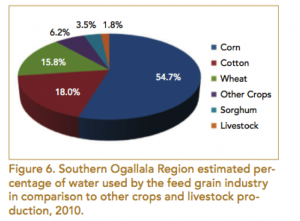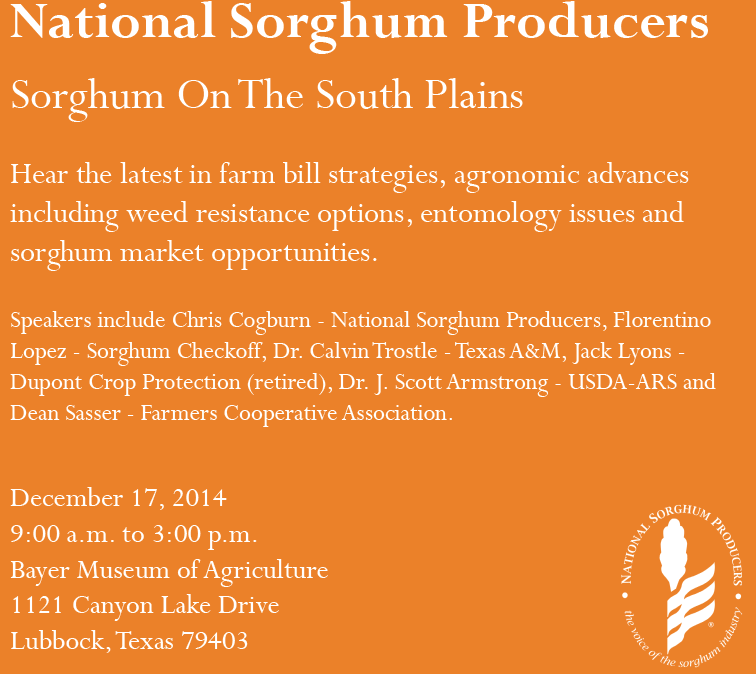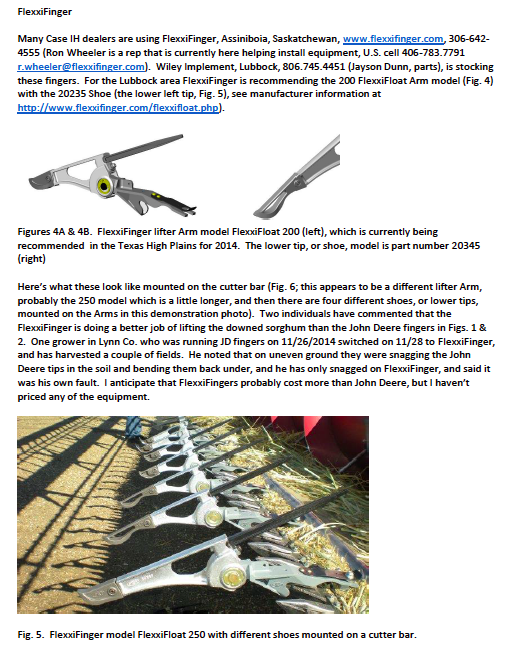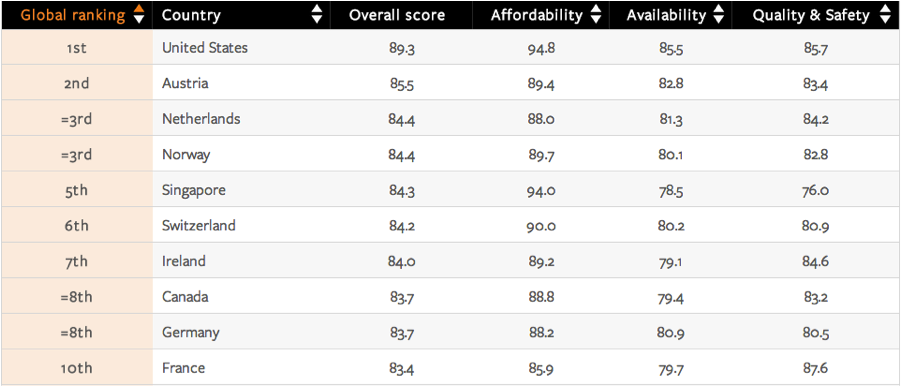- About UsTexas Grain Sorghum Association is….
- Texas Sorghum InsiderNewsletters…
- Legislative News
- Photos
- Contact UsTexas Grain Sorghum Association P.O. Box 905 Salado, TX 76571 Wayne Cleveland, Executive Director wcleveland@mindspring.com (254) 541.5375 Morgan Newsom, Producer Relations Coordinator morgan@texassorghum.org (806) 438.5994 SEND US A MESSAGE: [contact-form-7 404 "Not Found"]
- Sorghum Dashboard
- Events
December 10, 2014
Sugarcane Aphid Tolerant Sorghum Hybrids Announced – Recently, two sorghum seed companies, Monsanto and Chromatin, announced findings of sugarcane aphid tolerant sorghum hybrids. In a release Dec. 4, Monsanto said, “Third-Party evaluation performed by the U.S. Department of Agriculture in Stillwater, Okla., has confirmed that two DEKALB ® Sorghum products, DKS37-07 variety & PULSAR brand, exhibit a high level of genetic tolerance to the sugarcane aphid.
“In the screening evaluation, both products showed extremely low levels of chlorotic damage from the sugarcane aphid compared to the known tolerant check line TX2783. Additionally, DKS37-07 showed very positive plant height and early health ratings when exposed to the pest. These products combined with continued scouting and an effecting spray program as needed, will give growers the best opportunity to limit sugarcane aphid damage on their farms.”
Chromatin also released a statement regarding their resistant sorghum varieties.
“A third-party evaluation conducted by the Agricultural Research Service division of the USDA verified that several Sorghum Partners® brand sorghum hybrids exhibit strong tolerance to the sugarcane aphid pest. The use of SP6929, KS310, NK5418, and K73-J6 hybrids, as part of an Integrated Pest Management (IPM) program, can effectively reduce the impact of a sugarcane aphid infestation.” Please remember that these hybrids are not showing resistance but tolerance.
To read either release in their entirety follow the links: Monsanto Release / Chromatin Release.
High Plains & South Plains AgriLife Sorghum Variety Trials – Results for the Perryton Irrigated Trial, Hereford Irrigated Trial, Lubbock Dryland Trial and Lubbock Irrigated Trial have been posted on Texas A&M AgriLife’s Variety Testing website. Basic agronomic data and the top three yielding varieties are presented in the table below. For more details and results of all hybrids, please visit the AgriLife variety testing website. Results from other areas of the state that were harvested earlier in the year are also posted.
| Location | Date Planted | # of Varieties | MEAN Yield(lbs/A) | Previous Crop | Irrigation | Highest Yielding Variety | Second Highest Yielding Variety | Third Highest Yielding Variety |
| Hereford Irrigated | 5/20 | 51 | 6,718 | Fallow | 4.5” of row water on 7/23 | 8,306Monsanto Co.DEKALBDKS51-01 | 8,262MonsantoDEKALBDKS49-45 | 8,076Terral Seed Inc.REV®RV9562™ |
| Perryton Irrigated | 5/21 | 49 | 9,019 | Fallow | 5 furrow applications in season of approx3” each | 10,807Monsanto Co.DEKALBDKS53-53 | 10,652MonsantoDEKALBDKS53-67 | 10,294Armor Seed, LLCArmor BANDIT |
| Lubbock Irrigated | 5/21 | 47 | 4,244 | Sorghum | 1 pre-plant; 1 in-season of approx 4.5 acre inches | 5,785Alta SeedsAG3201 | 5,172Browning SeedChallenger BMX | 5,121Alta SeedsAG3101 |
| Lubbock Dryland | 7/19 | 29 | 1,763 | Cotton | 1 pre-plant of approx 4.5 acre inches for planting | 2,216AgriLifeATx2752xRTx430 | 2,170Terral Seed Inc.REV®TV9782™ | 2,145Monsanto Co.DEKALBDKS41-50 |
Upcoming Farm Bill Meetings
Friday, December 19
Floyd & Crosby County featuring Dr. Joe Outlaw (A&M ANFPC)
8:00 am – 11:00 am
Floyd Co. Unity Center
House Addresses Tax Extenders Issue – National Sorghum Producers (NSP) recently released information on the tax extender issue addressed in the House of Representatives last week where they voted to address several expired tax policies affecting farmers and ranchers. The House-passed legislation provides a one-year extension and includes the following pieces relevant to America’s sorghum farmers:
· Extends the Sec. 179 small business deduction of up to $500,000 for new/used equipment (Sec. 127 of the bill);
· Extends the 50 percent bonus depreciation for the first year on certain property purchased for business use (Sec. 125);
· Extends the charitable deduction for certain food donations (Sec. 126); and
· Extends the 50 percent deduction for landowners who give conservation easements to a government agency or land trust entity, and includes the enhanced dedication of up to 100 percent (over 16 years) for certain qualified farmers/ranchers (Sec. 106).
The Senate is expected to take up the measurement next week with the possibility it will go to the White House for the President’s signature in 10-15 days. NSP recently joined a group of agriculture and business groups in a letter to Members of Congress urging them address the tax policies. The letter can be read here.
November 19, 2014
International Sorghum Demand – While China’s presence in the U.S. market became noticed last year, they are certainly making a statement this year. China’s most recent purchase last week of 11.35 million bushels was the largest this marketing year. China purchased 60 percent of the U.S. sorghum crop in the 2013/2014 marketing year. Japan also purchased 2.3 million bushels of U.S. sorghum last week. Only two and a half months into the current marketing year (beginning Sept. 1), total export commitments of U.S. sorghum are already at 136.95 million bushels (China has purchased 87 percent of that total). Commitments during the 2013/2014 marketing year totaled 199 million total bushels. Japan, Canada and Korea are the only other known buyers at this stage.
Section 18 Extension – Texas received an amendment to the Section 18 for the use of sulfoxaflor. This amendment extend the use period with a new expiration date of December 10, 2014. View the new Section 18 Use Directions – 14TX02 Transform WG Amended Section 18 Use Directions exp 12.10.2014.
Global Food Security – As 150,000 new people are born every day the pressure to produce more food efficiently continues to increase. As nearly one billion go to bed hungry every night, DuPont is actively fighting world hunger on numerous levels. One of note however, is a new database the company sponsors called The Global Food Security Index. DuPont teamed up with a group of experts to take a closer look at food security and trends associated with it. The panel, ranging from the academic, non-profit and the government sector, assess the core issues of food affordability, availability and quality for 109 countries. This index is the first to examine food security comprehensively across the three internationally established dimensions. The study also looks beyond hunger to the underlying factors affecting food insecurity. To increase the ongoing relevance of the study the index is updated quarterly to reflect the risk countries face throughout the year. A version of the index along with graphics illustrating food security trends globally can be found at http://foodsecurityindex.eiu.com/.
Featured Sorghum Recipe
Gluten Free Sugar Cookies
3 cups sorghum flour
1/2cup coconut sugar
1 cup palm shortening (softened)
1/2 tsp baking powder
1/2 tsp baking soda
1/2 tsp sea salt
2 eggs1 tsp vanilla extract
1/4 cup almond milk
- Preheat oven to 350.
- In one bowl, mix all the dry ingredients together.
- In another bowl, mix the softened shortening and the sugar together.
- Then add in the vanilla and flax eggs.
- Add the dry ingredients to the wet and mix only until combined.
- If the batter looks too dry, add in the almond milk one tablespoon at a time.
- Gather the dough into a ball.
- Cut the dough in half.
- Wrap both pieces of dough and place in the fridge for 20 minutes.
- Grab one piece of the dough and roll onto a floured surface until it’s about 1/4 inch thick.
- Cut into shapes. Place the cookie shapes onto a lined baking sheet.
- Bake for about 10 minutes or until the cookie edges turn a golden brown.
- Let cookies completely cool before removing them from the baking sheet.
Repeat these steps with the second ball of dough.Store these cookies in an airtight container in the fridge. You can also freeze them for longer storage. Enjoy!
November 7, 2014
Feed Grain Production & Water Use – Irrigated feed grain production on approximately 3.5 million acres has led this industry to being the largest single user of water from the Southern Ogallala Region. Agriculture accounts for more than 90 percent of the water use in the region each year. The feed grain industry’s demand for water has local leaders concerned about whether feed grain production in the region is an appropriate use of these scarce water resources. As we enter an era where conservation is key a new way of thinking is necessary. Rather than assessing profit margins on a per acre basis, more focus should be shifted to profits per-inch, as future water demands will likely place more emphasis on drought tolerant traits. Sorghum, a crop known for its water sipping qualities is already ahead of the conservation curve.
 Irrigated feed grain water use was estimated by using information from the 2012 Texas Crop and Livestock Enterprise Budgets regarding yields and irrigation applied per acre. These budgets are developed pro forma, assuming average rainfall will occur. The crop yield was divided by the irrigation applied to estimate the average production per acre-inch of water applied. Total water applied was estimated by dividing the irrigated crop production by the respective production per acre-inch.
Irrigated feed grain water use was estimated by using information from the 2012 Texas Crop and Livestock Enterprise Budgets regarding yields and irrigation applied per acre. These budgets are developed pro forma, assuming average rainfall will occur. The crop yield was divided by the irrigation applied to estimate the average production per acre-inch of water applied. Total water applied was estimated by dividing the irrigated crop production by the respective production per acre-inch.
 There is no question that pressure for more drought tolerant crops will continue. Due to the shifted focus, even as irrigated feed grain acreage is projected to gradually shift to dryland, overall production is expected to remain stable as production per acre-inch of water should improve. This information was gathered from the Texas A&M AgriLife report, “AG-011: The Impact of the Feed Grains Industry in the Southern Ogallala Region”.
There is no question that pressure for more drought tolerant crops will continue. Due to the shifted focus, even as irrigated feed grain acreage is projected to gradually shift to dryland, overall production is expected to remain stable as production per acre-inch of water should improve. This information was gathered from the Texas A&M AgriLife report, “AG-011: The Impact of the Feed Grains Industry in the Southern Ogallala Region”.
Drought Tolerant Corn Hybrids Tapping a Deeper Soil Profile – Texas A&M AgriLife Research scientists in Amarillo are wrapping up a two-year study on “Water Use and Grain Yield in Drought-Tolerant Corn in the Texas High Plains“. Dr. Qingwu Xue, his research assistant Dr. Baozhen Hao, and many other team members compared two hybrids from Pioneer in the study. “One is 33D49, a very popular conventional hybrid in the Texas High Plains that doesn’t have the drought-tolerant trait, and AQUAmax P1151 HR, also from Pioneer, but with the drought-tolerant trait and in the market since 2012,” said Xue. The objective of the study was to compare water use and grain yield performance of the two corn hybrids at three irrigation levels. “Irrigation treatments consisted of 100 percent, 75 percent and 50 percent evapotranspiration requirements”, Hao said. Measurements included soil water content, soil water extraction, seasonal evapotranspiration, water-use efficiency, biomass and grain yield. “What we found was there was no difference in total evapotranspiration between the two hybrids, so they required a similar amount of water to produce corn; however, at the 50 percent evapotranspiration level, the drought-tolerant corn had a tendency to access more water from the deeper soil profile”, Xue said, “what we also found was in the AQUAmax hybrids, the yield was generally 10 to 15 percent higher than the traditional hybrid, especially in drought conditions such as the 50 percent evapotranspiration level. That’s a huge yield benefit under drought conditions.” Xue concluded, “what it means is the new AQUAmax hybrid has higher yield and higher water-use efficiency – up to 20 percent.”
FSA County Committee Elections – USDA is urging producers to vote in their current FSA County Committee elections. USDA mailed ballots on Nov. 3rd to eligible producers and ballots must be returned by Dec. 1st. If you did not receive a ballot and are eligible to vote, you may pick one up at your local USDA Service Center or FSA office. Elected committee members will take office on January 1, 2015. Committee members provide a connection between the local agricultural community and USDA. County committee members operate within official regulations designed so local input is provided on federal programs administered by FSA.
Sorghum Foodies – Sorghum, a crop that has traditionally taken a back seat to other commodities is beginning to get noticed, not only as a livestock feed but the ancient grain has also grabbed the attention of many foodies as a tasty and gluten free choice. Recently sorghum has been making headlines in numerous articles that have featured the grain in the kitchen. Most current, the Huffington Post ran a story titled “What is Sorghum? And Why is the South so Obsessed with it?” where the author highlighted the unique flavor and rich history that embodies sorghum. A handful of recipes starring sorghum accompany the article. To view the article, click here.
Sorghum has been gaining national attention in several media stories with titles including: “Sorghum: The Next Super Grain?“, “Is Sorghum Poised to ‘Really Take Off’ Soon?“, and “Sorghum’s Genetic Pipeline Stocked with Potential“.
October 23, 2014
Mexico Sorghum Buyers in Texas – Last week, prior to attending the USGC Export Exchange in Seattle, a group of sorghum buyers from Mexico toured the sorghum industry in Houston and the South Plains. The buyers represented feed mills, dairies, poultry companies and two of the largest cattle operations in Mexico. The group, sponsored by the USGC, TGSB and USCP, visited with various growers, seed companies, first handlers and end-users. In an average year, Mexico purchases 30 to 40 percent of the U.S. grain sorghum destined for export, equating to approximately 100 million bushels. Next week, a group of sorghum buyers from China will tour the High Plains and the Port of Houston. China has already committed to 2.3 million metric tons or 91.6 million bushels of grain sorghum. The international demand for US sorghum reached a record high spread at the Gulf of 130 percent the price of corn last week. Sorghum basis as high as $1.95 has been reported in the region.

A group of grain buyers from Taiwan visit the Sorghum Checkoff (USCP) booth at the USGC Export Exchange in Seattle this week. Pictured with the group is Florentino Lopez (Exec. Dir., USCP), Bill Kubecka (Board Member, USCP), and Wayne Cleveland (Exec. Dir., TGSP).
Export Exchange Exposes Need for More Sorghum – Sponsored by the US Grains Council (USGC) and the United Sorghum Checkoff Program (USCP), approximately 180 of grains best international customers gathered in Seattle to learn more about grain exports. USCP sponsored a booth that received an inordinate amount of attention due to the popularity of sorghum’s new market in Asia. “Most people that visited the booth wanted to know if more sorghum would be available and if growers have expressed an interest in planting more acres in years to come,” explained Wayne Cleveland, TGSP Executive Director. Concerns also focused around the movement of grain sorghum within constraints of ongoing rail issues and the need for more nutritional information among different species where grain sorghum has not been traditionally utilized. “Notably present at sorghum’s booth were end-users from Mexico that look forward to purchasing opportunities toward the beginning of the new year,’ said Cleveland. “Mexico has been a valued customer for a long time that understands the value of sorghum in their feed rations and looks forward to the opportunity to purchase more sorghum.”
South Plains Sugarcane Aphid Update – Please click here to view a special edition of the FOCUS on South Plains Agriculture newsletter released by the Texas A&M AgriLife Research & Extension Center at Lubbock. This edition summarizes the current status of sugarcane aphids on area sorghum crops. This month’s regular edition of their newsletter also focused on information about the sugarcane aphid. If you missed the initial edition of the newsletter this month, click here to view it.
APH Yield Exclusion to be Implemented for 2015 Spring Crops – Earlier this month, USDA announced it would delay implementing the Actual Production History (APH) Yield Exclusion for two years even though it was passed and signed into law. However, Agriculture Secretary Tom Vilsack announced earlier this week the implementation the APH initiative that will provide relief to farmers affected by severe weather, including drought. The APH Yield Exclusion allows farmers to exclude yields in exceptionally bad years from their production history when calculating yields used to establish their crop insurance coverage. Yields can be excluded from the farm APH when the county average yield for that crop year is at least 50 percent below the 10 previous consecutive crop year’s average yield. By excluding unusually bad years, farmers will not have to worry that a natural disaster will reduce their insurance coverage for years to come.
High Plains AgriLife Farm Bill Informational Meetings – Texas A&M AgriLife will host several educational meetings in District 1 concerning the new Farm Bill. The meetings are free and open to the public. The meetings will demonstrate the Farm Bill decision-aid tool to help producers economically evaluate program choices. AgriLife Extension economists will provide analysis of the policy options using examples of producers who have already been through the decision aid process. USDA FSA staff will also be at the meetings to discuss farm bill provisions, and sign-up requirements and deadlines. All meetings will begin at 10:00 a.m. and end at noon.Each location will also offer an optional “hands-on” afternoon session for producers wanting assistance entering their data into the decision-aid tool. A&M AgriLife is hosting the meetings and the series of meetings is cosponsored by the Texas Grain Sorghum Producers, Texas Wheat Producers, Texas Corn Producers, and the Plains Cotton Growers Association.
- Nov. 3 – Deaf Smith County, Hereford Community Center, Hereford
- Nov. 4 – Hall County, Kathy Fowler Building, Memphis
- Nov. 6 – Hall County, Bob Willis Center, Turkey
- Nov. 11 – Dallam/Hartley Counties, FBC Family Life Center, Spearman
- Nov. 12 – Moore County, Moore County Community Building, Dumas
- Nov. 13 – Wheeler County, Wheeler Co. Ag & Family Life Center, Wheeler
- Nov. 17 – Lipscomb County, Wolf Creek Heritage Museum, Lipscomb
- Nov. 18 – Potter County, Texas A&M AgriLife Center, Amarillo
- Nov. 19 – Ochiltree County, Ochiltree Expo Center, Perryton
- Nov. 20 – Randall County, Kuhlman Extension Center, Canyon
- Nov. 25 – Briscoe County, Happy State Bank Pioneer Room, Silverton
- Dec. 4 – Hemphill County, Hemphill Co. Exhibition Center, Canadian
- Dec. 5 – Donley County, Church of Christ Family Life Center, Clarendon
- Dec. 8 – Armstrong County, Armstrong Activity Center, Claude
- Dec. 10 – Oldham County, Oldham Co. Barn, Vega
- Dec. 11 – Roberts County, Roberts Co. Annex, Miami
- Dec. 16 – Carson County, War Memorial Building, Panhandle
- Dec. 17 – Gray County, Clyde Carruth Show barn in Recreation Park, Pampa
- Dec. 18 – Collingsworth County, Bura Handley Comm. Bldg., Wellington
Additional Farm Bill Meetings in Texas – In addition to the AgriLife District 1 meetings, AgriLife Extension in other areas are also holding Farm Bill informational meetings. Floyd County will have a meeting on Wednesday, October 29th from 9:00 am to 11:00 am at the Lighthouse Electric Coop in Floydada. Also, three counties in the Rio Grande Valley (Hidalgo, Cameron and Willacy) are teaming up and will hold a regional meeting on Thursday, Oct. 30th in the Hoglitzelle Auditorium at the A&M Research & Extension Center in Weslaco. Breakfast tacos and coffee will be available at 8:30 a.m. and the program will begin at 9:00 a.m.
Featured Sorghum Flour Recipe
Double Chocolate Peanut Butter Banana Muffins
1 cup Only Oats pure whole grain oat flour
1/3 cup cocoa powder
1/3 cup sorghum flour
1/4 cup tapioca starch
1 teaspoon baking powder
1 teaspoon baking soda
1 teaspoon xanthan gum
1/2 teaspoon salt
1 cup mashed overripe bananas (about 3 medium)
1/2 cup brown sugar, packed
1/2 cup sour cream or plain yogurt
1/3 cup oil
1/3 cup peanut butter or nut-free butter (Wowbutter worked great)
2 large eggs
1 teaspoon vanilla extract
1 cup semi-sweet chocolate chips
1. Preheat the oven to 350 degrees F. Lightly grease a 12 cup muffin tin. Set aside.
2. In a large bowl, whisk together the oat flour, cocoa powder, sorghum flour, tapioca starch, baking powder, baking soda, xanthan gum, and salt.
3. In another bowl, mix together the bananas (I like to mash mine with a potato masher), brown sugar, sour cream, oil, peanut butter, eggs, and vanilla until combined.
4. Pour the wet ingredients into the dry ingredients and stir just until blended. Stir in the chocolate chips.
5. Divide the batter between the 12 muffin cups.
6. Bake in preheated oven for 20-22 minutes, or until a toothpick inserted into the middle of a cupcake comes out clean.
7. Let muffins sit in the tin for a few minutes, before gently removing them to a wire cooling rack to cool completely. Store in an air-tight container in the fridge. Allow to come to room temperature before serving.
October 10, 2014
2014 Farm Bill & APH Issue – The 2014 Farm Bill requires USDA to provide immediate relief by allowing producers to elect to exclude any yield from their APH database in years where the yield of their county or an adjacent county was 50% lower than the 10-year average. In short, the provision of the law eliminates the double deductible effect the drought has worked on a producers’ APH and, in turn, on the amount of coverage that the producers is able to purchase. USDA has announced that they will administratively delay the provision (which was passed into law on February 7th) for two-years. The Southwest Council of Agribusiness (SWCA) recently sent a letter to USDA Secretary Tom Vilsack urging him to reconsider the Department’s two-year delay, and instead to implement this provision in time for the 2015 crop year. Click here to view SWCA’s letter. Members of Congress also need to hear from YOU! Please call or email the person who handles agriculture for your Member of Congress and urge them to reach out to USDA to carry out the law. Click here to contact your local congressman via the web. To read more about how this delay will impact agriculture, click here to view an article by DTN addressing this issue.
SXSW ECO Exposes the “other side” of Agriculture – The South by Southwest Eco (SXSW ECO) Conference was recently held in Austin and featured a number of “Agricultural” programs. In particular were panels that included “How To Feed 9 Billion People” (coincidentally it included nothing about effective government farm programs), “”What’s the Buzz on Bees” and “GMO’s – The Hype, The Hope, The Science”. Of note to the conference, in spite of a $395 registration fee, was the sheer number of young “activists” that attended the various sessions dealing with agriculture. While each seminar addressed a number of issues, it was clear, the large number of attendees were very outspoken against any chemical, antibiotic and GMO usage on the farm. Each of the seminars was standing room only and participant questions quickly turned into diatribes about mainstream agriculture. Producer perspectives were generally limited to smaller urban farmers and one session dealing with GMO’s was even sponsored by Mother Jones News while a SXSW employee criticized a major chemical company for paying for producers to attend the very same meeting. Despite the sessions being very limited in scientific review, the dairy panel included a very real perspective of organic farms and the very viable notion that we will never feed 9 billion people with organic farms but need to keep them strong, as markets still drive production and $35/cwt milk (as compared to regular market price of $15/cwt) is not sustainable to world consumers. One member of the panel (with one producer owning an impressive 20,000 head of organic milk cattle and managing 38,000 acres of land) also implied that GMO’s, in the future, could be a part of organic farms as science has yet to prove any detrimental data, which seemed to stun the crowd. Despite any leanings on how to farm, the growing concern that there is another side of agriculture that is very young, well financed, has time to commit, and does not prescribe to modern farming methods or programs should be on the minds of every grower in the nation.
Sorghum Checkoff Board Appointments – USDA Secretary Tom Vilsack announced on Oct. 3rd the appointments of five members to serve on the United Sorghum Checkoff Program (USCP) board of directors. Appointed members will serve three-year terms. The growers appointed to the board are: Adam Baldwin of Kansas; John Dvoracek of Nebraska; Dale Murden of Monte Alto, Texas; Billy Bridgeforth of Alabama (at-large); and Verity Ulibarri of New Mexico (at-large). The board is structured so that the state with the largest production is allocated five positions, the state with the second largest gets three positions, and the third largest gets one position. There are also four at-large national positions for which at least two representatives must be appointed from states other than the top three sorghum producing states which are already allotted a specific number of positions.
2014 Sorghum Variety Trials Test Results – There were some outstanding trials in 2014 completed by Texas A&M AgriLife Research & Extension. Results from 2014 are currently posted from trials in College Station, Danevang, Gregory, Hill County, Hondo, Monte Alto, and Thrall. To view the 2014 trial results and previous test results from prior years, click here. The website will continually be updated with more results as harvest continues across the state.
Farm Bill Decision Aids & Dates to Know – Farmers will be facing huge decisions in the coming months that will affect their operations for the next four years. To aid farmers in those decisions, USDA’s FSA has funded a couple of Farm Bill Decision Aids that are now available on the web. A duo effort from Texas A&M University’s Ag & Food Policy Center (AFPC) and the University of Missouri’s Food & Ag Policy Research Institute (FAPRI) decision aid tool can be found by clicking here. The University of Illinois also released the Agriculture Policy Analysis System (APAS) which can be found here. To view more information and other links to specific areas, click here. FSA has also released a FAQ website to help answer questions pertaining to the new programs – click here.
Also if you haven’t already heard, USDA announced the key dates for farmers regarding the new programs in the 2014 Farm Bill – Agricultural Risk Coverage (ARC) and Price Loss Coverage (PLC). Important dates include:
- Sept. 29, 2014 – Feb. 27, 2015 :: Reallocate Base Acres & Update Yields – Land owners may update their yield history and/or reallocate base acres at their local FSA office.
- Nov. 17, 2014 – March 31, 2015 :: ARC/PLC Election – Growers can make a one-time election of either ARC or PLC for the 2014 through 2018 crop years.
- Mid-April, 2015 – Summer, 2015 :: ARC/PLC Enrollment – Growers can sign contracts for 2014 and 2015 crop years.
- Oct., 2015 :: 2014 Payments – Payments for the 2014 crop year will be made if needed.
Sorghum Recipes
This is the first recipe in a new series we will begin running in our newsletter that will feature recipes that can be made with sorghum. Food sorghum is a healthy grain that is gaining popularity. We encourage you to take a look at the recipes, make them with your families or share these recipes with others. Wayne Cleveland, Executive Director of TGSP, will be showcasing food sorghum for Scott and White next week for 100 people where he will be using sorghum flour to make pancakes.
Sorghum Pancakes
2 cups sorghum flour
3 tsp baking powder
1 tsp sugar
¾ tsp salt
1 T corn oil
3 eggs
2 cups buttermilk
Combine dry ingredients.
Stir in eggs, oil and buttermilk and mix well.
Drop by spoonfuls onto a hot, 375 degree griddle until golden brown.
Flip once during cooking.
Recipe makes about 20 four-inch pancakes.
September 24, 2014
Sugarcane Aphid Webinar – The Coastal Bend Research and Extension Entomology team will provide a sugarcane aphid research update on a webinar tomorrow, September 25th, at 9:00 a.m. The webinar will provide a local perspective of sugarcane aphid sampling strategies, economic threshold, and results of efficacy studies to constituents in the Rio Grande Valley and Coastal Bend area of Texas. Click here to listen to the meeting by selecting “Guest” and entering your name. If you will be listening in, it is recommended that you do a system check prior to the start time by clicking here. Finally, if you are having issues with the system check, click here to view a handout on resolving system issues. The webinar will be streaming from the Texas A&M AgriLife Extension and Research Center in Corpus Christi.
Farm Facts by State – Farm Policy Facts unveiled a new interactive map highlighting state-specific agriculture contributions across the nation based on the USDA Ag Census data from 2012. Facts for all states include acreage, number of farms and farm receipts for each state, as well as links to full reports featuring information on top crops, typical farm size, and more. Click here to view the map. A few of the highlights from Texas include: leads the nation in cattle and calves, sheep, goats, horses, cotton, hay, wool and mohair; second largest ag state in the U.S., with agriculture contributing $27.6 billion to the state’s economy in 2013; more than 248,500 farms and 130 million acres of farmland; 209,551 farms have less than 500 acres; 17,309 farms have between 500-1000 acres, and 21,949 farms have more than 1,000 acres; agriculture employs one out of every seven people working in Texas; and almost 80 precent of the land in Texas is in some form in agriculture production.
FSA Acreage Histories – Under the 2014 Farm Bill, landowners will have a one-time opportunity to reallocate base acres and update patent yields of covered commodities on a farm. On July 28, the Farm Service Agency (FSA) sent out letters to farmers and landowners notifying them of their planted and considered planted acreage history from 2008 to 2012. The Summary Acreage History Report shows a farm’s base acres, counter-cyclical yields, and 2008-2012 planted, prevented, double-crop, and subsequent acres. This FSA acreage history for a farm will be the basis for making base reallocation decisions for the next 5 years. Farmers and landowners should double check the information to make sure it is accurate, but if it is incorrect or incomplete, you must contact your local FSA office before Sept. 26.
Young Farmers on the Rise – Farm Policy Facts looked close at the 2012 Ag Census and found that young, beginning principal operators who reported their primary occupation as farming increased 11.3 percent from 36,396 to 40,499 between 2007 and 2012. The article pinpointed the how important strong farm policy is as young farmers starting out face higher input costs and lower crop prices, unprecedented global subsidization, regulatory burdens, and vocal opponents determined to weaken the farm safety net. Some help young farmers will find is in the Beginning Farmer and Rancher Development Program (BFRDP), which funds farmer education programs, and through a micro loan program in the new Farm Bill that makes credit more available for beginning farmers. Although reports are showing a slight increase in the number of young farmers, it is noted that it is not nearly enough to offset the number of farmers rapidly approaching retirement age.
Sorghum Highlighted in Huffington Post – A recent article on Huffington Post’s website focused on a few ancient grains and their comeback to the grocery shelves. Sorghum was highlighted in the article as being “good for you by having more vitamins and nutrients as compared to modern wheat.” The article also pointed out that sorghum is “higher in antioxidants which are believed to help lower the risk of cancer, diabetes, and heart disease.” The writer, a pastry chef and author of ‘Sweet & Skinny’, then goes on to explain how these ancient grains that are making a comeback and are “quite delicious.” The article concludes with a recipe for a Blackberry and Blueberry Ancient Grain Gluten Free Crisp (pictured below) using sorghum flour as a main ingredient. Click here to read the full article and view the recipe.
September 4, 2014
 A “Look” at Sorghum International Markets – The Sorghum Checkoff (USCP) has created an infographic (pictured above) to demonstrate U.S. sorghum exports for the 2013/2014 marketing year. USCP, TGSB and the U.S. Grains Council (USGC) are actively engaged within many international markets, promoting the value of U.S. Sorghum abroad. Demand is increasing internationally and it is important for producer-funded programs to understand the international marketplace to facilitate the sell of sorghum overseas, which will in turn, strengthen producer opportunities. Buyers from Mexico and China will be in the Texas High Plains in October to continue to understand the U.S. sorghum crop with hopes that they will continue to, or begin buying U.S. sorghum. For more information, click here.
A “Look” at Sorghum International Markets – The Sorghum Checkoff (USCP) has created an infographic (pictured above) to demonstrate U.S. sorghum exports for the 2013/2014 marketing year. USCP, TGSB and the U.S. Grains Council (USGC) are actively engaged within many international markets, promoting the value of U.S. Sorghum abroad. Demand is increasing internationally and it is important for producer-funded programs to understand the international marketplace to facilitate the sell of sorghum overseas, which will in turn, strengthen producer opportunities. Buyers from Mexico and China will be in the Texas High Plains in October to continue to understand the U.S. sorghum crop with hopes that they will continue to, or begin buying U.S. sorghum. For more information, click here.
Proposition 1 – At the end of August, Texas Grain Sorghum Association held their summer board of directors meeting in Austin, Texas. The board voted to support Proposition 1 after hearing a presentation from Scott Haywood of the Move Texas Forward initiative. Proposition 1 will be on the November 2014 Texas ballot and is a constitutional amendment authorized by SJR 1, which legislators approved last year. The amendment would authorize disbursements from the state’s oil and gas production tax collections on the State Highway Fund. An estimated $1.7 billion would be transferred into the State Highway Fund for the first year alone. In other words, 50% of future funds that usually go into the Rainy Day Fund will now go into the State Highway Fund, while no money collected in the past will be moved from the Rainy Day Fund, there will just be 50% less going in. Funds can only be used for new construction and preservation of the state highway system and not for toll roads. The amendment does not raise taxes, fees or debt on citizens or businesses. The Move Texas Forward initiative, notes that Texas has not kept up with our transpiration infrastructure and the state is $5 billion short for roads annually. Based on research, Texas needs to invest $315 billion over the next two decades just to keep up with current congestion and maintenance levels. They also note there is expected to be another 18 million Texas vehicles by 2040. For more information, visit the Move Texas Forward website.
EPA’s Proposed Ag Workers Protection Standard – EPA’s proposed modernization of its agricultural workers protection standard, that has not been updated since 1992, drew fire last month as the comment period closed. The new rule increases training frequency and updates prevention and treatment requirements in pesticide exposure situations. It also says workers less than 16 years old cannot handle any pesticide. Over 70 Democrat House members told EPA in a letter last week the proposed rule is too weak, protections should be as stringent as in other work areas, and that the rule contains “serious flaws…that perpetuate inequity and continue to leave the men, women and children who produce our food less protected than other workers.” The lawmakers want more stringent requirements for emergencies, child-specific protections, including raising the age limit on handling pesticides from 16 to 18 years old, as well as medical monitoring of workers and protection from retaliation if a worker reports the misuse of a chemical. Additional information about specific changes can be found here.
August 13, 2014
DuPont & Advanta US Partner on Sorghum Trait – A joint agreement has been signed by DuPont Crop Protection and Advanta US to commercialize the DuPont Inzen Z herbicide-tolerance sorghum trait. This advancement in sorghum genetics will give growers greater ability to control yield-limiting grass weeds in grain sorghum including foxtail, barnyardgrass, crabgrass, and Texas panicum. DuPont’s North America Regional Director, James Hay, said that annual grass weeds reduce U.S. sorghum yield by approximately 20 percent. Advanta will be adding the trait to their premium Alta Seeds hybrids, stated Steve Ligon, managing director for Advanta US. The new trait will not hurt exports as the sorghum will still be non-GMO. The herbicide offered for this tolerant trait will be DuPont Zest; however, it is still under development and is not registered with EPA yet.
HPWD Approves Amended Plan – The High Plains Underground Water Conservation District No. 1 (HPWD) board of directors unanimously passed water conservation rules and a 10-year amended Management Plan outlining locally controlled goals and activities of the district. Under the changes, producers will be required to limit water consumption to 18 inches per acre annually. If growers voluntary opt to limit their production to a single crop, they will not be required to track their use. To track their water consumption, growers have a variety of options such as reporting energy consumption, meter readings, or by tracking systems on irrigation systems. The changes will go into effect on Jan. 1. Over the past 18-months, HPWD received various input from water users and held two public hearings in their district. The district covers 16-counties in the High Plains. Visit www.hpwd.com to see the complete rules document and the amended plan.
USDA WASDE – USDA released their current WASDE report on August 12, 2014. The report forecasted sorghum production at 19 million bushels higher this month to total 429 million bushels, with the forecast yield at 67.1, higher than last months projection by 3.0 bushels. Sorghum supplies for 2014/15 are projected 5 million bushels higher to total 455 million bushels as a 15-million-bushel increase in 2013/14 exports lowers 2014/15 beginning stocks. The projected sorghum exports for 2014/15 are raised 10 million bushels to total 190 million bushels. The current marketing year will end on Aug. 31, 2014. As of Aug. 1, China has committed to a total of 171 million bushels of U.S. grain sorghum for the current marketing year, representing 89 percent of U.S. sorghum exports. The new marketing year, beginning on Sept. 1 already has total commitments of 38.1 million bushels, and from that, China has committed to 28.8 million bushels. The average farm price for sorghum is projected from $3.30 to $4.00 per bushel, 10 cents lower on both ends from July.
TAWC Field Day – The Texas Alliance for Water Conservation (TAWC) will hold its 9th Annual Summer Field Day on Thursday, August 14, 2014 from 8:00am to 2:00pm at the Floyd County Unity Center in Muncy. The event is free of charge, lunch will be included, and CEU’s will be available. Topics will range from water planning and crop outlooks to a demonstration of how to use a Farm Bill Decision Aid. Participants will also travel to the field to learn about the technology growers in the project are implementing and how they can maximize water efficiency on your field. The program will conclude with a keynote address from Bech Bruun of the Texas Water Development Board. TAWC is a partnership of area producers, data collection technologies, and collaborating partners that include industries, universities, and government agencies. The project is composed of more than 20 producers and is over 6,000 acres across eight counties in the High Plains. For more info, visit www.depts.ttu.edu/tawc.
Kubecka Re-elected to USGC Board – The U.S. Grains Council held its Annual Board of Delegates meeting in Nebraska at the end of July to review global grain marketing strategies and elect a new board of directors. Ron Gray, a farmer from Illinois, was elected as the USGC chairman for 2014-15 and Bill Kubecka, a farmer from Palacious, Texas and a current Sorghum Checkoff board member, will stay on as the Sorghum Sector Director. TGSB works closely with USCG to sustain and increase international sorghum exports.
July 30, 2014
HPWD Public Hearings – The High Plains Underground Water Conservation District (HPWD) held its first public hearing in Levelland yesterday since announcing their proposed rules to their management plan. There were approximately 100 attendees present at the hearing and individuals were allowed to comment on the proposed rules to the HPWD Board of Directors. “During the rule revision process, HPWD’s Board of Directors and staff, have met with numerous industries and residents seeking input throughout the District,” said Kody Bessent, who handles legislative affairs to HPWD. “Public hearings are a vital part of the rule-making process because they allow additional opportunity for residents to provide final comments prior to adoption.” The final public hearing will be held on Tuesday, August 5, 2014 in Canyon at the Texas A&M AgriLife Extension Office from 3:00 – 6:00 p.m. If you are unable to attend the hearing in Canyon, you may submit your written comments to rulecomments@hpwd.com no later than 5:00 p.m. on August 5th. To view the proposed rules, visit www.hpwd.com.
FSA County Committee Nomination Deadline – August 1, 2014 is the postmark deadline for local Farm Service Agency (FSA) county committee nominations. County committees are an important link between the farm community and the USDA. The committees work closely with county executive directors and make decisions on disaster and conservation programs, emergency programs, commodity price support loans programs and other ag issues. Members serve three-year terms and consist of 11 members that are elected by eligible producers. Please visit www.fsa.usda.gov/elections to view more details.
Base Acre Reallocation Decisions – The Department of Agriculture, Environmental and Development Economics at Ohio State University and the Department of Agricultural and Consumer Economics at the University of Illinois shared an article that examines the decisions landlords will have to make regarding the opportunity to reallocate FSA base acres. There will be many decisions growers and landlords will have to make pertaining to the 2014 Farm Bill and the articles mentions that this decision is important because of the emerging low prices, because Price Loss Coverage (PLC) and Agriculture Risk Coverage (ARC) pay on base acres, and because the change in base acres can be substantive. To view the article, click here.
July 15, 2014
HPWD Public Hearings – The High Plains Underground Water Conservation District (HPWD) has released their draft proposed rules for their management plan and are seeking public comments and testimony at two hearings in their region. The first hearing will be held on July 29 at the Mallet Event Center in Levelland and the second hearing will be held on August 5 at the Kuhlman Center in Canyon. Both hearings are scheduled for 3:00 – 6:00 pm. Written comments and questions may also be submitted to the HPWD by mail or by email at rulecomments@hpwd.com. The draft of the proposed revisions may be found here.
Potential Milo-Pro Use on Cotton – The Texas Department of Agriculture (TDA) requested an exemption from Section 18 of EPA’s Fungicide and Rodenticde Act (FIFRA) to use a registered pesticide for unregistered use for a limited time. TDA requested to use Propazine, more commonly known as Milo-Pro, to treat up to three million acres of cotton to control glyphosate-resistant Palmer amaranth or Pigweeds. TDA has noted that Propazine is needed due to the lack of suitable alternatives and effective control practices. TDA also noted that significant economic losses will occur if this weed is not controlled. Milo-Pro is currently approved by EPA for use on grain sorghum in Texas, Oklahoma, New Mexico, Colorado and Kansas. Comment period closed on July 3, 2014 and over 500 were received.
Food for Thought – A study conducted by USDA’s Economic Research Service recently provided facts that may be surprising to some. The study found that the US spends very little on food when compared to other countries. The average American uses 6.6 percent of their budget on food consumed at home and when eating out, costs are added and the grand total rises to 11 percent. This might be hard to put into perspective until you realize, on average, Canadians spends 9.9 percent of their budget on food consumed at home, Italians uses 14.2 percent of their budget for food consumed at home and Mexicans spends nearly one quarter of their yearly budget on food. Researchers attribute the differences in spending to a number of factors, one simply being that Americans are richer. Other influences do matter though, such as differing tax systems, dining out habits and food prices. Although farm subsidies and advancements in industrial agriculture come with some debate they have also been credited with keeping the sticker price of food at the grocery store lower in the U.S.
Sorghum Insider Program – Registration for the Sorghum Insider, an exclusive three-day program, which will take place Aug. 20-22 in Lubbock is now open. The program is hosted by National Sorghum Producers and is for industry partners, elevators and end-users. The program will take participants through the U.S. sorghum industry from beginning to end, covering all of the important issues impacting production, policy, markets and more. Congressman Mike Conaway will be joining the program. To register call 800-658-9808 or to view more info, visit www.SorghumGrowers.com/sorghuminsider.
USCP Concludes 5-Year Genetic Project – The Sorghum Checkoff (USCP), in collaboration with NuSeed/MMR Genetics an USDA’s Agricultural Research Service, recently completed a five-year, $600,000 investment in a project to help broaden the pool of available sorghum genetics. Over the five years, the program converted wild-type sorghum varieties not suitable for U.S. breeding programs into genetic lines that are more easily incorporated into established breeding and research programs. Justin Weinheimer, USCP Crop Improvement Director, said a total of 144 new sources of sorghum genetics were released to breeding programs across the country. A total of 15 different breeding and research progress have acquired some or all of this material and are incorporating it into their programs. Weinheimer also noted to USCP, “the results of this project are directly tied to making more productive hybrids, which in turn results in higher profitability for producer.”














